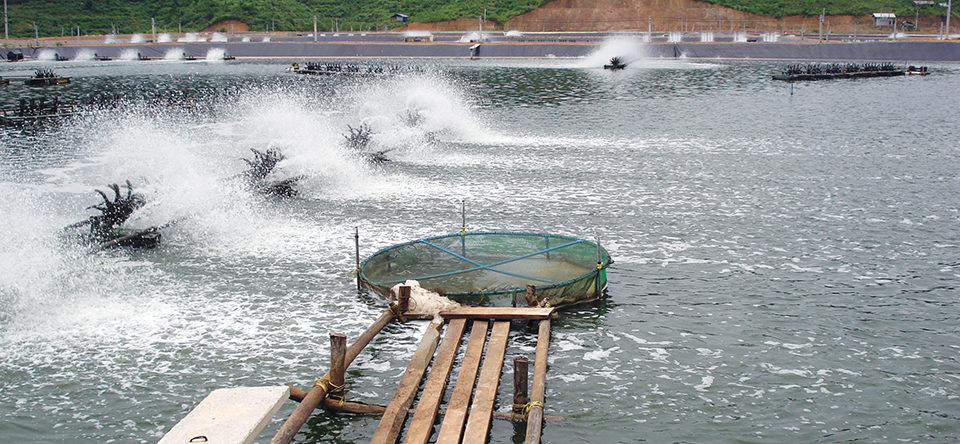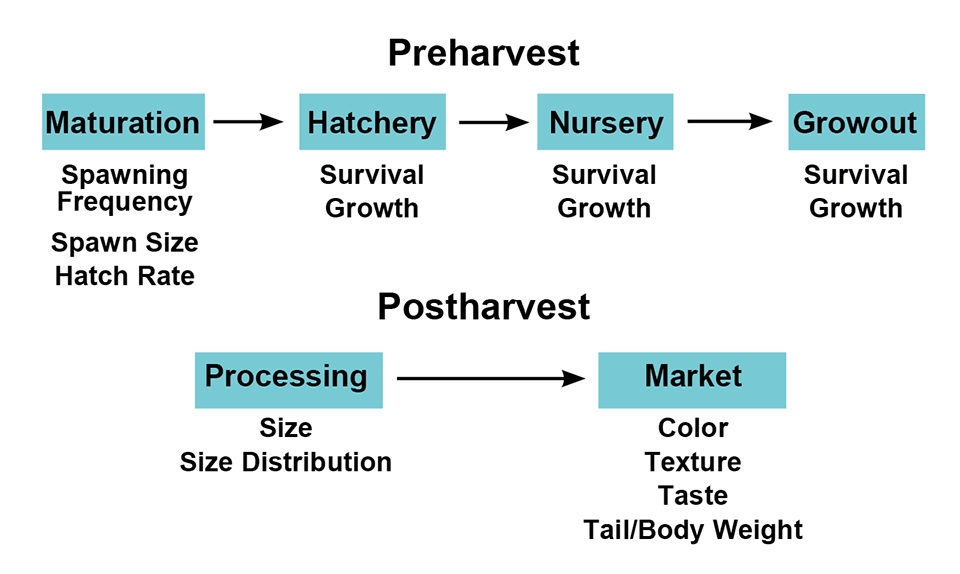Global shrimp-farming industry: loosely affiliated stakeholders

In the 1990s, a number of research and commercial shrimp-breeding programs emerged and generated basic information about the quantitative genetics of penaeid shrimp. Importantly, these programs provided evidence that selective breeding of shrimp can be effective in improving traits of commercial importance, such as growth and disease resistance.
Although selective breeding offers a tremendous opportunity for increased production and profitability to shrimp farmers, there are significant obstacles to large-scale investment in genetic improvement programs.
Inbreeding problems
Commercial shrimp hatcheries throughout Asia and Latin America typically use broodstock shrimp of unknown pedigree. This was an acceptable practice when broodstock were collected from the wild. However, most broodstock now used by the industry come from captive stocks of Pacific white shrimp (Penaeus vannamei), which likely originated from a narrow genetic base.
As a consequence, these stocks are highly susceptible to inbreeding depression (IBD). IBD is the effect of inbreeding measured as a reduction in mean phenotypic performance with increasing levels of inbreeding within a population.
Research conducted at Oceanic Institute in Hawaii, USA, indicated that IBD negatively impacts shrimp reproductive performance and disease resistance (Table 1). For example, a 10 percent increase in inbreeding resulted in a 12 percent reduction in hatch rate, an 11 percent reduction is hatchery survival and a 31 percent reduction in survival after exposure to the Belize isolate of Taura syndrome virus (TSV).
Moss, Inbreeding depression expressed, Table 1
| Trait | Depression (%) |
|---|
Trait | Depression (%) |
|---|---|
| Hatch rate (%) | -12.3 |
| Hatchery survival (%) | -11.0 |
| Growth rate (g/week) | -3.6 |
| Survival to Taura syndrome virus, Americas group (%) | -8.8 |
| Survival to Taura syndrome virus, Belize group (%) | -31.4 |
| Survival to White spot syndrome virus (%) | -38.7 |
Not coincidentally, the costs of postlarvae produced from F1 and F2 generation broodstock are much lower in some Asian countries because their performance is inferior to that of postlarvae produced from first-generation broodstock. This decline in performance can likely be attributed to IBD.
In the absence of accurate pedigree information, it is imperative for hatchery managers – and broodstock-importing countries – to ensure that their broodstock have sufficient genetic diversity. If not, problems associated with inbreeding depression may result in reduced production and profitability.
Inadequate farm biosecurity
Despite efforts by many shrimp farmers to minimize the introduction and spread of pathogens on their farms, diseases continue to plague the global shrimp-farming industry. This situation has serious consequences for shrimp breeders because the value of selectively bred shrimp can not be fully realized if shrimp are grown in environments with virulent pathogens or widely fluctuating environmental conditions.
Although some commercial lines of shrimp exhibit high survival after TSV exposure, these shrimp do not exhibit enhanced resistance to other pathogens such as White spot syndrome virus. It is important for farmers using selectively bred shrimp to adopt cost-effective strategies that mitigate the risk of pathogen introduction into their grow-out ponds and standardize grow-out conditions so the genetic potential of their crops can be fully realized.
Industry fragmentation
Currently, the global shrimp-farming industry can be characterized as a variety of loosely affiliated stakeholders who participate in the shrimp production process. The stakeholders include broodstock suppliers, hatchery operators, grow-out farmers, feed companies, processing plants and others.
In some parts of Asia, the division of labor is more complex, with each stakeholder in the process chain trying to maximize profit margins. From a shrimp-breeding standpoint, this fragmentation is an impediment because each stakeholder places a different priority on which trait or traits should be selected (Fig. 1).

For example, a hatchery manager may want lines of shrimp that exhibit high fecundity or hatch rate. A grow-out farmer typically wants shrimp that survive well and grow fast in ponds, and a shrimp processor may want shrimp of uniform size. As shrimp consumers become more sophisticated, they may want shrimp that have a certain texture or appearance.
It is impossible for a shrimp breeder to select for all of these traits concurrently while optimizing genetic gains, and little is known about the genetic correlations among these (and other) traits. As the global shrimp-farming industry consolidates and becomes more vertically integrated, the economic value of commercially important traits over the entire process chain will dictate which traits will be selected.
Customized shrimp
Some commercial shrimp hatcheries obtain broodstock from independent breeding programs or broodstock suppliers. Typically, these broodstock are selected based on criteria that may not be relevant to the end user, such as using TSV-resistant shrimp in a biosecure facility or in a region where TSV does not exist.
Although there is a paucity of published data about genotype x environment interactions for shrimp, research conducted at Oceanic Institute indicated a significant interaction for grow-out survival. This suggested that different shrimp lines need to be developed for different environments in order to optimize survival and production.
This can be accomplished by conducting on-farm evaluations at end users’ facilities. Harvest data from on-farm evaluations can then be used by shrimp breeders to “customize” the shrimp to the unique conditions of a particular farm, region or season. This approach will likely become more common as the shrimp-farming industry matures and becomes more vertically integrated.
(Editor’s Note: This article was originally published in the November/December 2008 print edition of the Global Aquaculture Advocate.)
Now that you've finished reading the article ...
… we hope you’ll consider supporting our mission to document the evolution of the global aquaculture industry and share our vast network of contributors’ expansive knowledge every week.
By becoming a Global Seafood Alliance member, you’re ensuring that all of the pre-competitive work we do through member benefits, resources and events can continue. Individual membership costs just $50 a year. GSA individual and corporate members receive complimentary access to a series of GOAL virtual events beginning in April. Join now.
Not a GSA member? Join us.
Authors
-
Shaun M. Moss, Ph.D.
Oceanic Institute
41-202 Kalanianaole Highway
Waimanalo, Hawaii 96795 USA -
Dustin R. Moss, M.S.
Oceanic Institute
41-202 Kalanianaole Highway
Waimanalo, Hawaii 96795 USA -
Steve M. Arce
Oceanic Institute
41-202 Kalanianaole Highway
Waimanalo, Hawaii 96795 USA -
Clete A. Otoshi, M.S.
Oceanic Institute
41-202 Kalanianaole Highway
Waimanalo, Hawaii 96795 USA
Related Posts

Health & Welfare
A holistic management approach to EMS
Early Mortality Syndrome has devastated farmed shrimp in Asia and Latin America. With better understanding of the pathogen and the development and improvement of novel strategies, shrimp farmers are now able to better manage the disease.

Intelligence
A motive, and a market, for farmed fish in Mexico
Boasting ample areas for aquaculture and a robust domestic demand for seafood – not to mention its close proximity to the U.S. market – a land of opportunity lies in Mexico. Fish farming is primed to meet its potential south of the border.

Health & Welfare
A study of Zoea-2 Syndrome in hatcheries in India, part 1
Indian shrimp hatcheries have experienced larval mortality in the zoea-2 stage, with molt deterioration and resulting in heavy mortality. Authors investigated the problem holistically.

Health & Welfare
A study of Zoea-2 Syndrome in hatcheries in India, part 2
Indian shrimp hatcheries have experienced larval mortality in the zoea-2 stage, with molt deterioration and resulting in heavy mortality. Authors considered biotic and abiotic factors. Part 2 describes results of their study.


